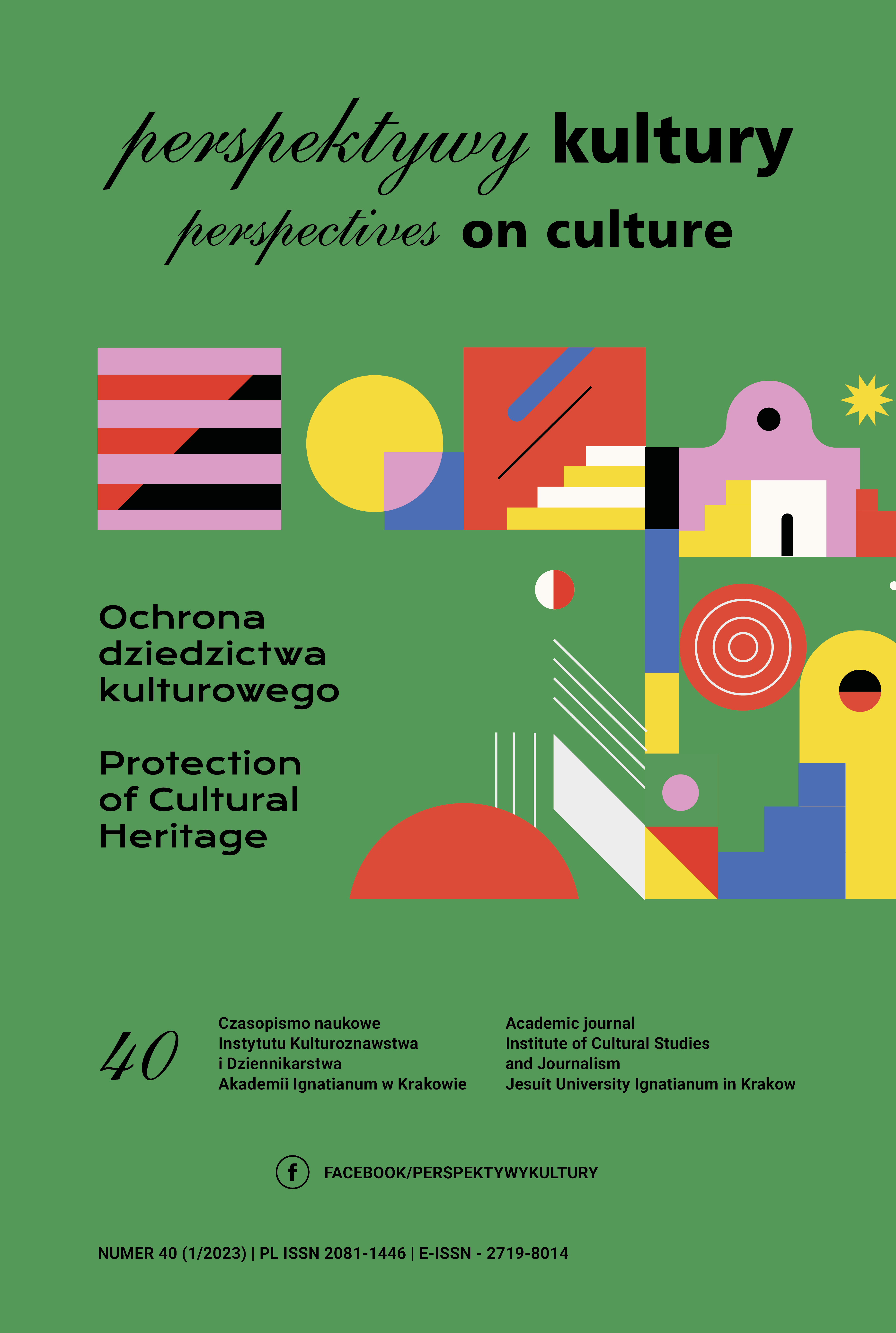Monitoring Cultural Heritage. An Analysis of Contemporary Practices for Data Collection
Abstract
Monitoring the impact of cultural heritage on socio-economic development is becoming a necessity, including justifying the preservation of heritage in contemporary societies. It provides arguments showing the importance of cultural heritage for strengthening the sustainable functioning of the socioeconomic environment. The last decades of the 20th century involved great interest in the topic of indicators relating to the measurement of the cultural sector – on the international arena (UNESCO Framework for Cultural Statistics), on the European arena (eg European Network for Cultural Statistics) and the national one. Important research was also undertaken on local or regional scales, striving to capture the value of cultural heritage (e.g., the Cultural Heritage Counts for Europe study carried out in 2013–2015). The aim of the article is to identify and characterize the currently practiced approaches to monitoring the impact of cultural heritage on socio-economic development. Based on the desk research analysis and case study method, model solutions for collecting statistical data on cultural heritage in Australia, Iceland, Germany, the United States, Switzerland and the United Kingdom were examined. As a result, four approaches to collecting data on cultural heritage and its impact on socio-economic development were distinguished.
References
Appendino, F. (2018). Heritage-related Indicators for Urban Sustainable Development: A Systematic Review. Urban Transportation and Construction, 4(1), https://doi.org/10.18686/utc.v4i1.32
Babbie, E. (2005). Podstawy badań społecznych. Warszawa: Wydawnictwo Naukowe PWN.
Baycan, T. i Girard, L. (2011). Heritage in socio-economic development: direct and indirect impacts. ICOMOS, Paryż. Pozyskano z: https://openarchive.icomos.org/id/eprint/1299/1/IV-2-Article9_Baycan_Girard.pdf (dostęp: 01.12.2022).
Blomkamp, E. (2015). A Critical History of Cultural Indicators. W: L. MacDowall, M. Badham, E. Blomkamp i K. Dunphy (red.), Making Culture Count. The Politics of Cultural Measurement. Londyn: Palgrave Macmillan, 11−26.
Cultural Heritage Counts for Europe (2015). CHCfE Consortium, Międzynarodowe Centrum Kultury, Krakow. Pozyskano z: http://blogs.encatc.org/ culturalheritagecountsforeurope/wp-content/uploads/2015/06/CHCfE_ FULL-REPORT_v2.pdf (dostęp: 01.12.2022).
Eisenhardt, K. (1984). Building Theories from Case Study Research. The Academy of Management Review, 14(4), 532−550.
Garzillo, C., Balenciaga, I., Izulain, A. Escribano, T.R. i Wildman A. (2020). Adaptive Reuse of Cultural Heritage. An Examination of Circular Governance Models from 16 International Case Studies. CLIC Project. Pozyskano z: https://iclei-europe.org/publications-tools/?c=search&uid=ewTajtJT (dostęp: 01.12.2022).
Góral, A. (2017). Ekologia dziedzictwa. Przyczynek do tematu. Zarządzanie Publiczne, 2(38), https://doi.org/0.4467/20843968ZP.16.011.7226
Hall, S. (red.) (1997). Representation: Cultural Representations and Signifying Practices. Londyn: Sage/Open University.
Jelincic, D.A. (2021). Indicators for Cultural and Creative Industries’ Impact Assessment on Cultural Heritage and Tourism. Sustainability, 13, 7732, https://doi.org/ 10.3390/su13147732
Kirshenblatt-Gimblett, B. (2004). Intangible Heritage as Metacultural Production. Museum International, 1–2 (56), 52–65.
Konwencja ramowa Rady Europy w sprawie znaczenia dziedzictwa kulturowego dla społeczeństwa z 27 października 2005 r., Narodowy Instytut Dziedzictwa. Pozyskano z: www.nid.pl/upload/iblock/844/8445eee1eed20 fe93856a52376d47eaa.pdf (dostęp: 21.10.2017)
Konwencja UNESCO w sprawie ochrony niematerialnego dziedzictwa kulturowego z 2003 r., UNESCO. Pozyskano z: www.unesco.pl/filead- min/user_upload/pdf/Konwencja_o_ochronie_dz._niemater_2003.pdf (dostęp: 15.05.2022).
Konwencja w sprawie ochrony światowego dziedzictwa kulturalnego i naturalnego z 16 listopada 1972 r., UNESCO. Pozyskano z: www.unesco.pl/ fileadmin/user_upload/pdf/Konwencja_o_ochronie_swiatowego_dziedzictwa.pdf (dostęp: 01.12.2022).
Kostera, M. (2003). Antropologia organizacji. Metodologia badań terenowych. Warszawa: Wydawnictwo Naukowe PWN.
Landorf, Ch. (2009). A Framework for Sustainable Heritage Management: A Study of UK Industrial Heritage Sites. International Journal of Heritage Studies, 15, 494–510, https://doi.org/10.1080/13527250903210795
MacDowall, L., Badham, M., Blomkamp, E. i Dunphy, K. (2015). Making Culture Count. Londyn: Palgrave Macmillan.
Marilena, V. (2010). A definition of cultural heritage: From the tangible to the intangible. Journal of Cultural Heritage, 11(3), 321–324, https://doi. org/10.1016/j.culher.2010.01.006.
Murzyn-Kupisz, M. (2013). The socio-economic impact of heritage projects conducted by private investors. Journal of Cultural Heritage, 14, 2, 156–162. Murzyn-Kupisz, M., Hołuj, D. i Działek, J. (2022). Społeczno-ekonomiczne oddziaływanie dziedzictwa kulturowego Stan badań oraz perspektywy i potrzeby badawcze w kontekście polskim. Warszawa–Kraków: Narodowy Instytut Dziedzictwa, Instytut Geografii i Gospodarki Przestrzennej, Uniwersytet Jagielloński.
Nocca, F. (2017). The Role of Cultural Heritage in Sustainable Development: Multidimensional Indicators as Decision-Making Tool. Sustainability, 9, 1882, https://doi.org/10.3390/su9101882
Plevoets, B. i Cleempoel, K. (2019). Adaptive Reuse of the Built Heritage: Concepts and Cases of an Emerging Discipline. Londyn: Routledge.
Rizzo, I. i Mignosa, A. (2013). Handbook on the Economics of Cultural Heritage. Cheltenham-Northampton: Edward Elgar.
Smith, L. (2006). Uses of Heritage. Londyn: Routledge. Sułkowski, Ł. (2005). Epistemologia w naukach o zarządzaniu. Warszawa: PWE. Thurley, S. (2005). Into the Future. Our Strategy for 2005–2010. Conservation Bulletin. English Heritage, nr 49.
Tomaszewski, A. (2013). Ku nowej filozofii dziedzictwa. Kraków: MCK.
Torre, M. i Mason, R. (2002). Assessing the Values of Cultural Heritage. Los Angeles: The Getty Conservation Institute. Pozyskano z: https://www. getty.edu/conservation/publications_resources/pdf_publications/values_ cultural_heritage.html (dostęp: 01.12.2022).
Unesco Culture 2030 Indicators (2019). Paris: UNESCO World Heritage Centre, Sustainable Development Goals. Pozyskano z: https://unesdoc. unesco.org/ark:/48223/pf0000371562 (dostęp: 01.12.2022).
Vecco, M. i Srakar, A. (2018). The unbearable sustainability of cultural heritage: An attempt to create an index of cultural heritage sustainability in conflict and war regions. Journal of Cultural Heritage, nr 33, 293–302, https://doi.org/10.1016/j.culher.2018.06.009
Copyright (c) 2023 Jesuit University Ignatianum in Krakow

This work is licensed under a Creative Commons Attribution-NoDerivatives 4.0 International License.
Autor, zgłaszając swój artykuł, wyraża zgodę na korzystanie przez Wydawnictwo Uniwersystet Ignatianum z utworu na następujących polach eksploatacji:
- utrwalania utworu w formie papierowej, a także na nośniku cyfrowym lub magnetycznym;
- zwielokrotnienia utworu dowolną techniką, bez ograniczenia ilości wydań i liczby egzemplarzy;
- rozpowszechniania utworu i jego zwielokrotnionych egzemplarzy na jakimkolwiek nośniku, w tym wprowadzenia do obrotu, sprzedaży, użyczenia, najmu;
- wprowadzenia utworu do pamięci komputera;
- rozpowszechniania utworu w sieciach informatycznych, w tym w sieci Internet;
- publicznego wykonania, wystawienia, wyświetlenia, odtworzenia oraz nadawania i reemitowania, a także publicznego udostępniania utworu w taki sposób, aby każdy mógł mieć do niego dostęp w miejscu i czasie przez siebie wybranym.
Wydawca zobowiązuje się szanować osobiste prawa autorskie do utworu.





